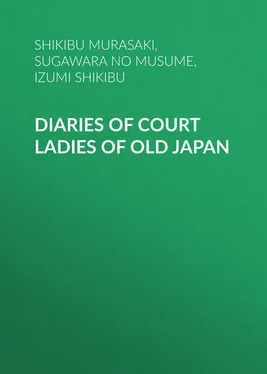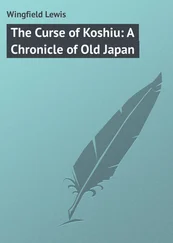Shikibu Murasaki - Diaries of Court Ladies of Old Japan
Здесь есть возможность читать онлайн «Shikibu Murasaki - Diaries of Court Ladies of Old Japan» — ознакомительный отрывок электронной книги совершенно бесплатно, а после прочтения отрывка купить полную версию. В некоторых случаях можно слушать аудио, скачать через торрент в формате fb2 и присутствует краткое содержание. Жанр: История, foreign_edu, на английском языке. Описание произведения, (предисловие) а так же отзывы посетителей доступны на портале библиотеки ЛибКат.
- Название:Diaries of Court Ladies of Old Japan
- Автор:
- Жанр:
- Год:неизвестен
- ISBN:нет данных
- Рейтинг книги:4 / 5. Голосов: 1
-
Избранное:Добавить в избранное
- Отзывы:
-
Ваша оценка:
- 80
- 1
- 2
- 3
- 4
- 5
Diaries of Court Ladies of Old Japan: краткое содержание, описание и аннотация
Предлагаем к чтению аннотацию, описание, краткое содержание или предисловие (зависит от того, что написал сам автор книги «Diaries of Court Ladies of Old Japan»). Если вы не нашли необходимую информацию о книге — напишите в комментариях, мы постараемся отыскать её.
Diaries of Court Ladies of Old Japan — читать онлайн ознакомительный отрывок
Ниже представлен текст книги, разбитый по страницам. Система сохранения места последней прочитанной страницы, позволяет с удобством читать онлайн бесплатно книгу «Diaries of Court Ladies of Old Japan», без необходимости каждый раз заново искать на чём Вы остановились. Поставьте закладку, и сможете в любой момент перейти на страницу, на которой закончили чтение.
Интервал:
Закладка:
But, after all, diseases and conflagrations are seldom more than episodes in a normal life lived under sane conditions, and it is just because these Diaries reflect the real life of these three ladies that they are important. The world they portray is in most ways quite as advanced as our own, and in some, much more so. Rice was the staple of food, and although Buddhistic sentiment seldom permitted people to eat the flesh of animals, they had an abundance of fish, which was eaten boiled, baked, raw, and pickled, and a quantity of fruits and nuts. There was no sugar, but cakes were made of fruit and nuts, and there was always rice-wine or saké. Gentlefolk usually dressed in silk. They wore many layers of coloured garments, and delighted in the harmony produced by the colour combinations of silk over silk, or of a bright lining subdued by the tone of an outer robe. The ladies all painted their faces, and the whole toilet was a matter of sufficient moment to raise it into a fine art. Many of these lovely dresses are described by Murasaki Shikibu, for instance: "The beautiful shape of their hair, tied with bands, was like that of the beauties in Chinese pictures. Lady Saémon held the King's sword. She wore a blue-green patternless karaginu and shaded train with floating bands and belt of 'floating thread' brocade dyed in dull red. Her outer robe was trimmed with five folds and was chrysanthemum coloured. The glossy silk was of crimson; her figure and movement, when we caught a glimpse of it, was flower-like and dignified. Lady Ben-no-Naishi held the box of the King's seals. Her uchigi was grape-coloured. She is a very small and smile-giving person and seemed shy and I was sorry for her… Her hair bands were blue-green. Her appearance suggested one of the ancient dream-maidens descended from heaven." A little later she tells us that "the beaten stuffs were like the mingling of dark and light maple leaves in Autumn"; and, describing in some detail the festivity at which these ladies appeared, she makes the comment that "only the right body-guard wore clothes of shrimp pink." To one in love with colour, these passages leave a very nostalgia for the bright and sophisticated Court where such things could be.
And everywhere, everywhere, there is poetry. A gentleman hands a lady a poem on the end of his fan and she is expected to reply in kind within the instant. Poems form an important part in the ritual of betrothal. A daughter of good family never allowed herself to be seen by men (a custom which appears to have admitted many exceptions). A man would write a poetical love-letter to the lady of his choice which she must answer amiably, even should she have no mind to him. If, however, she were happily inclined, he would visit her secretly at night and leave before daybreak. He would then write again, following which she would give a banquet and introduce him to her family. After this, he could visit her openly, although she would still remain for some time in her father's house. This custom of love-letter writing and visiting is shown in Izumi Shikibu's Diary. Obviously the poems were short, and here, in order to understand those in the text, it may be well to consider for a moment in what Japanese poetry consists.
Japanese is a syllabic language like our own, but, unlike our own, it is not accented. Also, every syllable ends with a vowel, the consequence being that there are only five rhymes in the whole language. Since the employment of so restricted a rhyme scheme would be unbearably monotonous, the Japanese hit upon the happy idea of counting syllables. Our metrical verse also counts syllables, but we combine them into different kinds of accented feet. Without accent, this was not possible, so the Japanese poet limits their number and uses them in a pattern of alternating lines. His prosody is based upon the numbers five and seven, a five-syllable line alternating with one of seven syllables, with, in some forms, two seven-syllable lines together at the end of a period, in the manner of our couplet. The favourite form, the "tanka," is in thirty-one syllables, and runs five, seven, five, seven, seven. There is a longer form, the "naga-uta," but it has never been held in as high favour. The poems in the Diaries are all tankas in the original. It can be seen that much cannot be said in so confined a medium, but much can be suggested, and it is just in this art of suggestion that the Japanese excel. The "hokku" is an even briefer form. In it, the concluding hemistich of the tanka is left off, and it is just in his hemistich that the meaning of the poem is brought out, so that the hokku is a mere essence, a whiff of an idea to be created in full by the hearer. But the hokku was not invented until the fifteenth century; before that, the tanka, in spite of occasional attempts to vary it by adding more lines, changing their order, using the pattern in combination as a series of stanzas, etc, reigned practically supreme, and it is still the chief classic form for all Japanese poetry.
Having briefly washed in the background of the Diaries, we must notice, for a moment, the three remarkable ladies who are the foreground.
Murasaki Shikibu was the daughter of Fujiwara Tametoki, a scion of a junior branch of the famous family. She was born in 978. Murasaki was not her real name, which was apparently To Shikibu (Shikibu is a title) derived from that of her father. There are two legends about the reason for her receiving the name Murasaki. One is that she was given it in playful allusion to her own heroine in the "Genji Monogatari," who was called Murasaki. The other legend is more charming. It seems that her mother was one of the nurses of Mikado Ichijo, who was so fond of her that he gave her daughter this name, in reference to a well-known poem:
"When the purple grass (Murasaki) is in full colour,
One can scarcely perceive the other plants in the field."
From the Murasaki grass, the word has come to mean a colour which includes all the shades of purple, violet, and lavender. In 996, or thereabouts, she accompanied her father to the Province of Echizen, of which he had become governor. A year later, she returned to Kiōto, and, within a twelvemonth, married another Fujiwara, Nobutaka. The marriage seems to have been most happy, to judge from the constant expressions of grief in her Diary for her husband's death, which occurred in 1001, a year in which Japan suffered from a great pestilence. A daughter was born to them in 1000. From her husband's death, until 1005, she seems to have lived in the country, but in this year she joined the Court as one of Queen Akiko's ladies; before that, however (and again I must insist that these early dates are far from determined), she had made herself famous, not only for her own time, but for all time, by writing the first realistic novel of Japan. This book is the "Genji Monogatari" or "Narrative of Genji."
Hitherto, Japanese authors had confined themselves to stories of no great length, and which relied for their interest on a fairy or wonder element. The "Genji Monogatari" struck out an entirely new direction. It depicted real life in Kiōto as a contemporary gentleman might have lived it. It founded its interest on the fact that people like to read about themselves, but this, which seems to us a commonplace, was a glaring innovation when Murasaki Shikibu attempted it; it was, in fact, the flash from a mind of genius. The book follows the life of Prince Genji from his birth to his death at the age of fifty-one, and the concluding books of the series pursue the career of one of his sons. It is an enormous work, comprising no less than fifty-four books and running to over four thousand pages – the genealogical tree of the personages alone is eighty pages long – but no reader of the Diary will need to be convinced that the "Genji" is not merely sprightly and captivating, but powerful as well. The lady was shrewd, and if she were also kindly and very attractive, nevertheless she saw with an uncompromising eye. Her critical faculty never sleeps, and takes in the minutest detail of anything she sees, noting unerringly every little rightness and wrongness connected with it. She watches the approach of the Mikado, and touches the matter so that we get its exact shade: "When the Royal palanquin drew near, the bearers, though they were rather honourable persons, bent their heads in absolute humility as they ascended the steps. Even in the highest society there are grades of courtesy, but these men were too humble."
Читать дальшеИнтервал:
Закладка:
Похожие книги на «Diaries of Court Ladies of Old Japan»
Представляем Вашему вниманию похожие книги на «Diaries of Court Ladies of Old Japan» списком для выбора. Мы отобрали схожую по названию и смыслу литературу в надежде предоставить читателям больше вариантов отыскать новые, интересные, ещё непрочитанные произведения.
Обсуждение, отзывы о книге «Diaries of Court Ladies of Old Japan» и просто собственные мнения читателей. Оставьте ваши комментарии, напишите, что Вы думаете о произведении, его смысле или главных героях. Укажите что конкретно понравилось, а что нет, и почему Вы так считаете.












